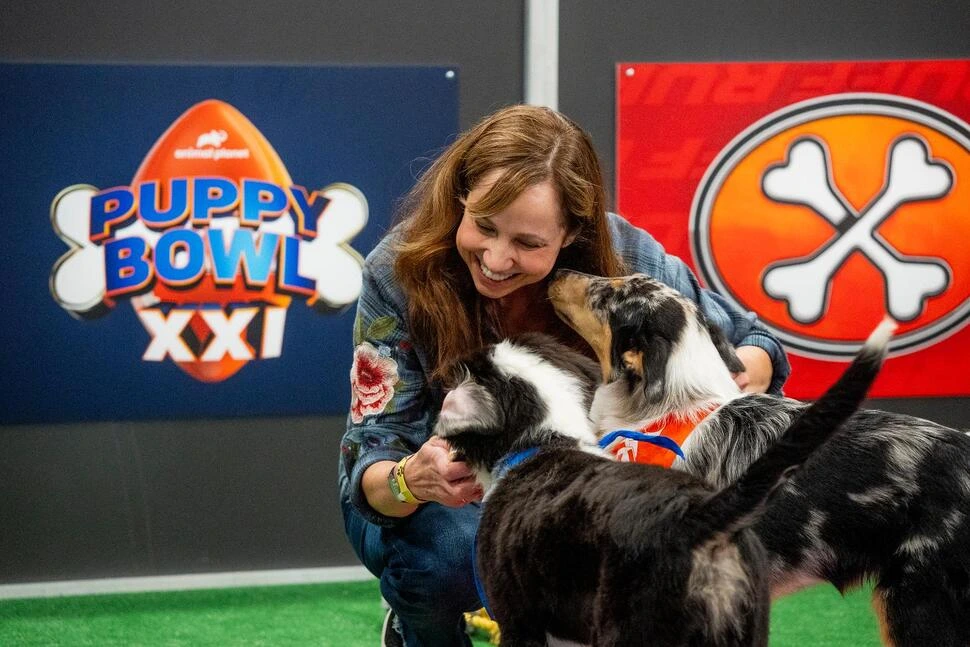Victoria Schade: The Heart Behind the “Puppy Bowl”
NEW YORK (AP) — When you tune into this year’s “Puppy Bowl,” you might not see Victoria Schade on screen, but her influence is everywhere.
As the show’s lead puppy trainer and wrangler, Schade ensures the adorable shelter pups have a smooth, conflict-free experience while being captured at their most irresistible moments—all from behind the scenes.
It’s Schade who helps the puppies focus during the national anthem and guides them through tunnels to the field for their big debut. She’s constantly watching for signs of discomfort or tension among the players.
“My main job is making sure the puppies are happy and safe during gameplay,” she explains. “If any pup looks overwhelmed or needs a break, I’ll step in and give them a timeout on the sidelines.”
A Puppy Bowl veteran, Schade has been part of the Animal Planet event for 19 years, making her one of its longest-serving crew members. She also oversees the kitten halftime show and calls filming this annual event her favorite week of the year.
“Victoria is one of the most dedicated and hardworking people in this industry,” says referee Dan Schachner, now in his 14th season. “She never seems to run out of energy, never turns down a request, and always brings positivity to every moment.”
Although she has trained countless puppies over the years, Schade had never adopted one from the show—until now. This year, she took home Boris, known on-screen as Mr. Pickles, from Dallas Dog Rescue. “I saw something special in him,” she says. “This was the year.”
The Secret to Puppy Engagement? Treats and Funny Noises
Schade originally helped select the show’s canine participants, a task now handled by rescue organizations and shelters across the country. These days, she focuses on training.
“If you see a puppy looking up at the camera, chances are I’m right there with a treat,” she reveals. “It’s all about snacks and silly sounds—they work every time.”
This year, Schade is stepping in front of the camera, joining Schachner for a special pre-game show featuring a doggy combine and draft. The event will also include appearances by Dan Smyers from country duo Dan + Shay and Kansas City Chiefs defensive tackle Derrick Nnadi.
Schade has also developed a unique skill over the years—anticipating puppy bathroom breaks.
“One of my Puppy Bowl talents is reading butts,” she jokes. “I can usually predict when a puppy is about to go, so I’ll call it out—‘Watch out at the 20-yard line, we’ve got a situation!’—and the crew is ready to clean up.”
More Than Just Cute Pups—It’s About Adoption
Originally launched as an alternative to the Super Bowl in 2005, the Puppy Bowl is a playful spectacle where puppies score touchdowns by crossing the goal line with a toy in their mouth. But beyond the cuteness, the show promotes animal adoption.
According to the ASPCA, approximately 390,000 shelter dogs are euthanized annually, while 2 million find new homes. Most of the puppies featured in the show are adopted before airtime, since filming happens in the fall, but the message is clear—countless loving pets are waiting in shelters at any given time.
This year’s three-hour event features 142 rescue puppies from 80 shelters across 40 states—and even one from Nicaragua, a Chihuahua-German Shepherd mix. There will also be 11 special needs dogs, the most in Puppy Bowl history.
“Look out for Jolene, a pit bull mix in a wheelchair,” says Schachner. “There’s also a three-legged Boston Terrier from New York City, and my personal favorite, Sprinkle, a blind and deaf Australian Shepherd. Watching them play is just incredible.”
With 6 million viewers tuning in for the first Puppy Bowl and 12.6 million last year, the show has become a beloved tradition—outperforming even this year’s Golden Globes, which drew 9.3 million viewers.
Schade’s Advice for Raising a Happy Pup
Beyond her work on Puppy Bowl, Schade is an experienced dog trainer and author of several pet-themed books, including Bonding With Your Dog, Life on the Leash, and Dog Friendly.
Her biggest tip for dog owners? Learn to read your pup’s body language.
“Tail-wagging can mean different things—how tight is the wag? Where is the tail positioned?” she explains.
Schade is a strong advocate for positive reinforcement and science-based training, rejecting the outdated “alpha dog” approach that relies on intimidation.
“You don’t need to be the alpha—that’s been debunked,” she says. “You’re your dog’s ally, their best friend. It’s all about compassion and understanding.”
And her number one rule for training? Treats—lots of them.
“When you think you’re giving enough treats, give more,” she advises. “Puppyhood is a critical learning period, and every interaction is a teaching opportunity.”
